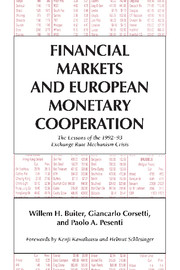 Financial Markets and European Monetary Cooperation
Financial Markets and European Monetary Cooperation Book contents
- Frontmatter
- Contents
- Forewords by Kenji Kawakatsu and Helmut Schlesinger
- Acknowledgments
- 1 Introduction
- 2 Exchange rate stability in Europe: A historical perspective
- 3 The unfolding of the 1992–93 ERM crisis
- 4 Financial markets and ERM credibility
- 5 Modelling currency crises
- 6 A Center–Periphery model
- 7 Unilateral pegs and escape clauses: The role of domestic credibility
- 8 Policy coordination and currency crises
- 9 What caused the system to crumble?
- 10 Rebuilding the system: What next?
- References
- Index
6 - A Center–Periphery model
Published online by Cambridge University Press: 06 July 2010
- Frontmatter
- Contents
- Forewords by Kenji Kawakatsu and Helmut Schlesinger
- Acknowledgments
- 1 Introduction
- 2 Exchange rate stability in Europe: A historical perspective
- 3 The unfolding of the 1992–93 ERM crisis
- 4 Financial markets and ERM credibility
- 5 Modelling currency crises
- 6 A Center–Periphery model
- 7 Unilateral pegs and escape clauses: The role of domestic credibility
- 8 Policy coordination and currency crises
- 9 What caused the system to crumble?
- 10 Rebuilding the system: What next?
- References
- Index
Summary
Introduction
The goal of the next four chapters is to offer a systematic approach to the theory of currency crises in a multicountry setup. Chapter 6 introduces our analytical framework. Focusing on the strategic interactions between the private and public sectors in a representative country, as well as the mechanism of expectations formation, Chapter 7 presents the key results of the unilateral peg literature as special cases of our model. Chapter 8, instead, devotes particular attention to the role played by international policy spillovers in the demise of a fixed exchange rate system and explores in detail the systemic dimensions of the monetary policy game. Finally, Chapter 9 focuses on the implications of the systemic view for our reconstruction of the 1992–93 ERM events.
Following the recent literature, the modelling strategy we adopt here considers an exchange rate crisis primarily as the rational policy response to excessive welfare costs of defending a peg. As a result, our construction excludes a number of analytical elements that play a key role in the traditional theory of balance of payments crises (Krugman, 1979; Flood and Garber, 1983, 1984). For instance, in our model money demand is not assumed to be interest sensitive, whereas this assumption is a crucial building block in the exogenous-policy literature. By the same token, our model does not explicitly consider the role of international reserves, either as a constraint or as an objective.
- Type
- Chapter
- Information
- Financial Markets and European Monetary CooperationThe Lessons of the 1992–93 Exchange Rate Mechanism Crisis, pp. 93 - 107Publisher: Cambridge University PressPrint publication year: 1998


